 Trigonometric Values of Special Angles
Trigonometric Values of Special Angles
With the work done in prior sections (particularly those listed below), we have everything needed to efficiently find exact values for things like $\,\cos\frac{81\pi}{4}\,$ and $\,\csc (-2640^\circ)\,.$
- Special Triangles and Common Trigonometric Values
- Reference Angles
- Radian Measure
- the Trigonometric Functions
- Signs of All the Trigonometric Functions
All the necessary tools/ideas are repeated below, in-a-nutshell. Having trouble following the brief discussion on this page? If so, review the links above (in order)—they offer a much slower and kinder approach.
Two Special Triangles
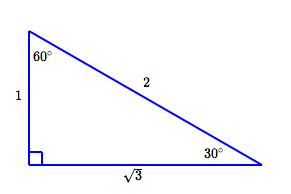
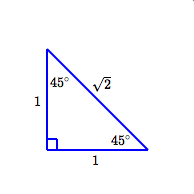
SOHCAHTOA
Sine
Opposite
Hypotenuse
Cosine
Adjacent
Hypotenuse
Tangent
Opposite
Adjacent
Reciprocal Relationships for Trig Functions
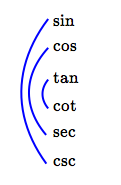
For example: $\displaystyle\csc = \frac{1}{\sin}$
Trigonometric Values of Small Special Angles
| angle/number |
| sine, $\,\sin = \frac{\text{OPP}}{\text{HYP}}$ |
| cosine, $\,\cos = \frac{\text{ADJ}}{\text{HYP}}$ |
| tangent, $\,\tan = \frac{\text{OPP}}{\text{ADJ}}$ |
| cotangent (reciprocal of tangent) |
| secant (reciprocal of cosine) |
| cosecant (reciprocal of sine) |
| angle/number | $0^\circ = 0 \text{ rad}$ |
| sine | $0$ |
| cosine | $1$ |
| tangent | $0$ |
| cotangent | not defined |
| secant | $1$ |
| cosecant | not defined |
| angle/number | $\displaystyle 30^\circ = \frac{\pi}{6} \text{ rad}$ |
| sine | $\displaystyle\frac 12$ |
| cosine | $\displaystyle\frac{\sqrt 3}2$ |
| tangent | $\displaystyle\frac1{\sqrt 3} = \frac{\sqrt 3}{3} $ |
| cotangent | $\sqrt 3$ |
| secant | $\displaystyle\frac{2}{\sqrt 3} = \frac{2\sqrt 3}{3}$ |
| cosecant | $2$ |
| angle/number | $\displaystyle 45^\circ = \frac{\pi}{4} \text{ rad}$ |
| sine | $\displaystyle\frac 1{\sqrt 2} = \frac{\sqrt 2}{2}$ |
| cosine | $\displaystyle\frac 1{\sqrt 2} = \frac{\sqrt 2}{2}$ |
| tangent | $1$ |
| cotangent | $1$ |
| secant | $\sqrt 2$ |
| cosecant | $\sqrt 2$ |
| angle/number | $ \displaystyle 60^\circ = \frac{\pi}{3} \text{ rad}$ |
| sine | $\displaystyle\frac{\sqrt 3}{2}$ |
| cosine | $\displaystyle \frac{1}{2}$ |
| tangent | $\displaystyle \sqrt 3$ |
| cotangent | $\displaystyle\frac1{\sqrt 3} = \frac{\sqrt 3}{3} $ |
| secant | $2$ |
| cosecant | $\displaystyle\frac{2}{\sqrt 3} = \frac{2\sqrt 3}{3}$ |
| angle/number | $\displaystyle 90^\circ = \frac{\pi}{2} \text{ rad}$ |
| sine | $1$ |
| cosine | $0$ |
| tangent | not defined |
| cotangent | $0$ ($\cot := \frac{\cos}{\sin}$) |
| secant | not defined |
| cosecant | $1$ |
Signs ($\pm$) of Sine, Cosine, and Tangent in All Quadrants
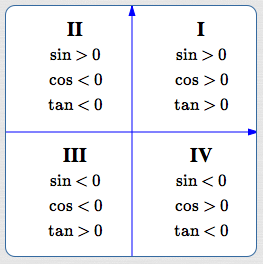
Reciprocals retain the sign ($+/-$) of the original number. Therefore, in all the quadrants:
- Cosecant has the same sign as sine.
- Secant has the same sign as cosine.
- Cotangent has the same sign as tangent.
Trigonometric Values for Arbitrary Special Angles
In Special Triangles and Common Trigonometric Values, the ‘Locate-Shrink/Size-Signs’ method was introduced for finding trigonometric values of special angles. With additional tools and terminology now at hand, that discussion is presented more generally and efficiently here.
The RRQSS (Reduce-Reference/Quadrant-Size/Sign) Technique
Reduce:
[This step is optional. If your angle isn't too big (say, $\,510^\circ\,$ or $\,-\frac{7\pi}{3}\,$), then it may be easy for you to find its reference angle and quadrant, without ‘reducing’ it first. Your choice!]
As discussed in Reference Angles, remove any extra rotations from $\,\theta\,$:
| $\theta\,$ in DEGREES |
|
| $\theta\,$ in RADIANS |
|
Reference/Quadrant:
Lay off $\,\theta\,$ in the standard way:
- Start at the positive $x$-axis
- Positive angles are swept out in a counterclockwise direction; start by going up
- Negative angles are swept out in a clockwise direction; start by going down
Determine the reference angle/number for $\,\theta\,.$
Determine the quadrant for $\,\theta\,.$
Size/Sign:
Use the reference angle/number to find the correct size of the desired trigonometric value.
Use the quadrant to find the correct sign of the desired trigonometric value.
Examples
In this first example, the angles aren't too big, so the optional (reduce) step is skipped.
| Find: $\,\sec 510^\circ\,$ | |
| Reduce |
(skipped)
[Dr. Burns would work with $\,510^\circ - 360^\circ = 150^\circ\,.$] |
|
Reference/ Quadrant |
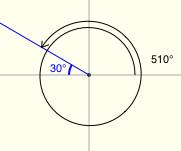
$\,510^\circ\,$ is in quadrant II; the reference angle is $\,30^\circ\,$ |
| Size/Sign |
Size: $\displaystyle\sec 30^\circ = \frac{2}{\sqrt 3}\,$ Sign: In quadrant II, the secant is negative. Thus: $$\sec 510^\circ = -\frac{2}{\sqrt 3}$$ |
| Find: $\displaystyle\,\cot (-\frac{7\pi}{3})\,$ | |
| Reduce |
(skipped)
[Dr. Burns would work with $\,-\frac{7\pi}3 + \frac{6\pi}3 = -\frac{\pi}3\,.$] |
|
Reference/ Quadrant |
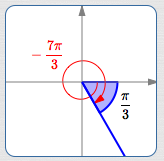
$\displaystyle\,-\frac{7\pi}{3}\,$ is in quadrant IV; the reference angle is $\,\displaystyle\frac{\pi}{3}$ |
| Size/Sign |
Size: $\displaystyle\cot\frac{\pi}{3} = \frac{1}{\sqrt 3}\,$ Sign: In quadrant IV, the cotangent is negative. Thus: $$\cot(-\frac{7\pi}{3}) = -\frac{1}{\sqrt 3}$$ |
In this final example, the angles are very big, so get rid of extra rotations (reduce) in the first step:
| Find: $\,\csc(-2640^\circ)$ | |
| Reduce |
$$\cssId{s134}{\frac{|\theta|}{360^\circ} = \frac{2640^\circ}{360^\circ} \approx 7}$$
$$\cssId{s135}{-2640^\circ + 7\cdot 360^\circ = -120^\circ}$$
Work with $\,-120^\circ\,$ instead of $\,-2640^\circ\,.$ |
|
Reference/ Quadrant |
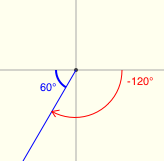
$\,-120^\circ\,$ is in quadrant III; the reference angle is $\,60^\circ\,$ |
| Size/Sign |
SIZE: $\displaystyle\csc 60^\circ = \frac{2}{\sqrt 3}\,$ SIGN: In quadrant III, the cosecant is negative. Thus: $$\csc(-2640^\circ) = -\frac{2}{\sqrt 3}$$ |
| Find: $\displaystyle\,\cos (\frac{81\pi}{4})\,$ | |
| Reduce |
$$\cssId{s142}{\frac{|\theta|}{2\pi} = \frac{81\pi/4}{2\pi} \approx 10}$$
$$\cssId{s143}{\frac{81\pi}{4} - 10\cdot 2\pi = \frac{81\pi}{4} - \frac{80\pi}{4} = \frac{\pi}4}$$
Work with $\displaystyle\,\frac{\pi}4\,$ instead of $\displaystyle\,\frac{81\pi}4\,.$ |
|
Reference/ Quadrant |
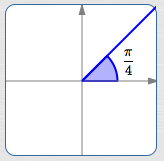
$\,\frac{\pi}4\,$ is in quadrant I; the reference angle is $\,\displaystyle\frac{\pi}{4}$ |
| Size/Sign |
SIZE: $\displaystyle\cos\frac{\pi}{4} = \frac{1}{\sqrt 2}$ SIGN: In quadrant I, the cosine is positive. Thus: $$\cos\frac{81\pi}{4} = \frac{1}{\sqrt 2}$$ |